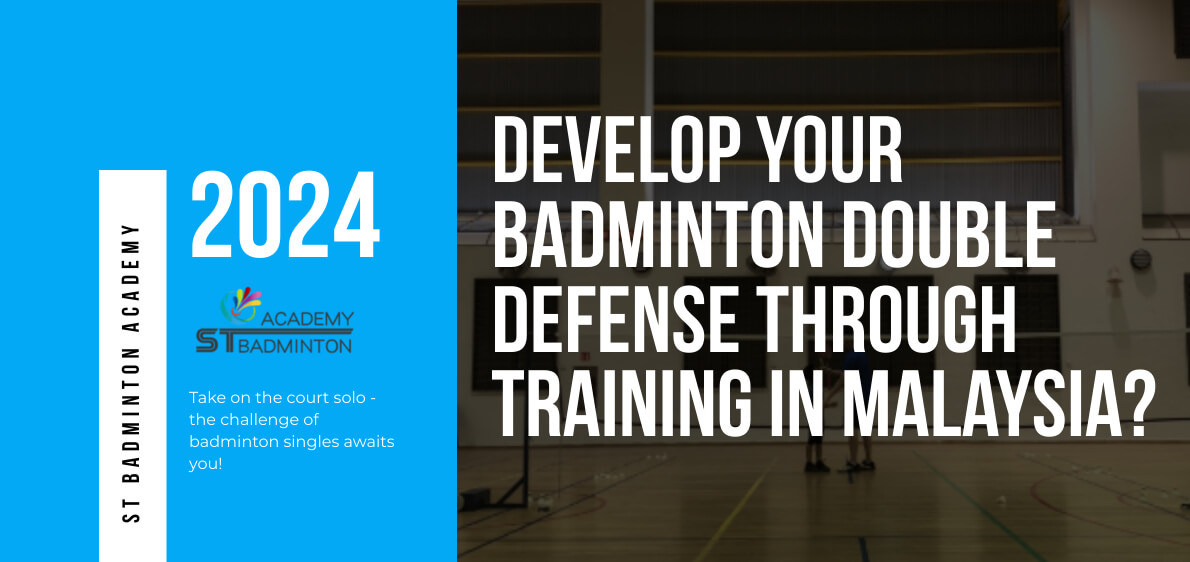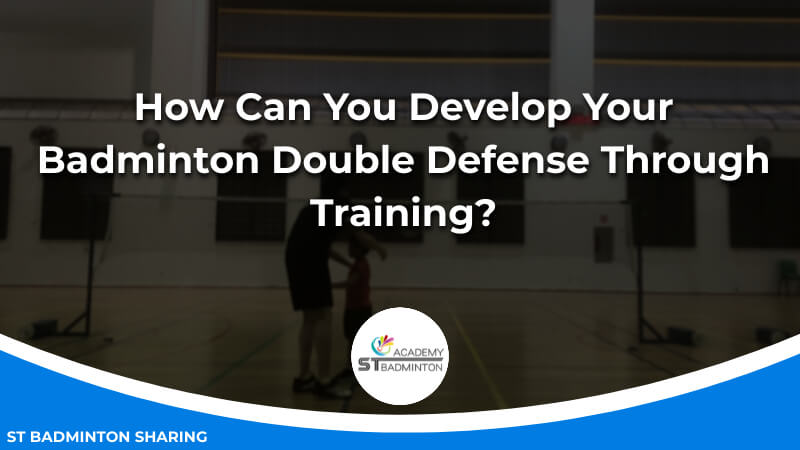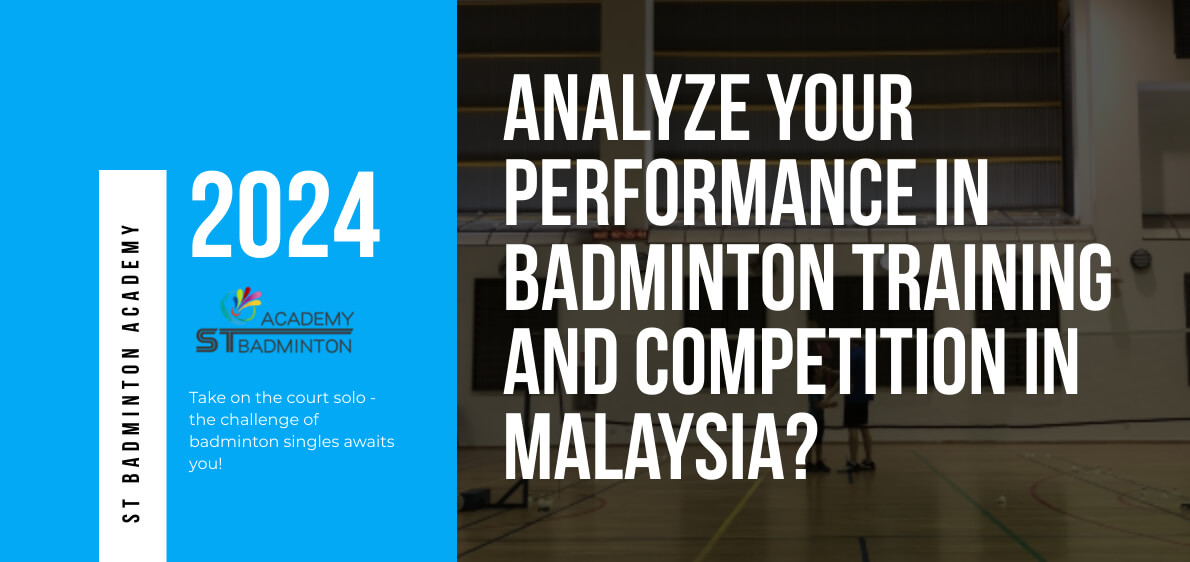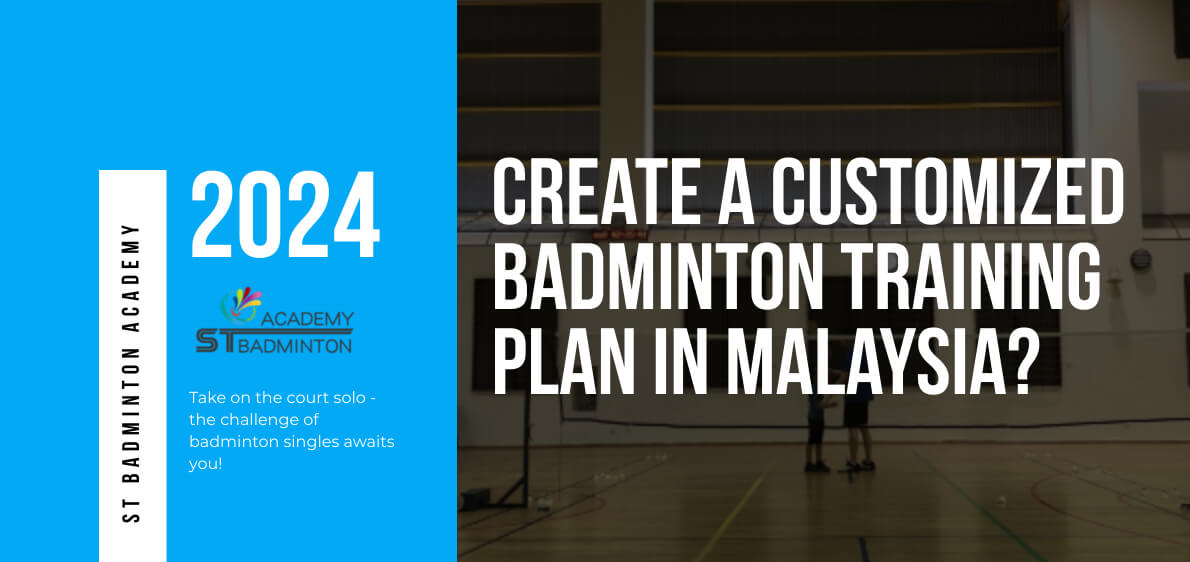Welcome to ST Badminton Academy’s badminton training in Malaysia! Today I’m here to talk about how you can develop your double defense through training. This is something that every competitive doubles pair needs to do, and it’s also a great way for singles players to practice their game. With some dedication, you’ll be able to make big improvements in no time. So let’s get started!
Now, the key to developing your double defense comes down to the drills you choose. You need to focus on those areas of your game where you’re weakest so that you can turn them into strengths. That means making sure each drill challenges both partners – even if one partner is more experienced than the other – and has enough variety so that you don’t get bored or stuck in a rut.

Footwork Drills
As a badminton coach, I know that developing your double defense through training requires coordination and agility. To get the best results from any practice session, it’s important to focus on building up these skills with drills that target both directly.
One of my favorite drills is one where two players stand facing each other and perform hopping movements in alternating directions while maintaining their balance. This helps to develop coordination between partners by teaching them how to move together quickly and efficiently in response to an opponent’s movement. It also serves as a good warm-up drill for more advanced defensive scenarios within the game.
I often supplement this exercise with quick footwork exercises such as side shuffles, jumps and lunges which help build overall strength and speed of motion – essential elements of effective doubles defence! Working on these drills will help you become better at anticipating opponents’ moves and being able to react faster when defending against them. With enough practice you’ll be ready to take your defense skills to the next level – serve and return drills!
Serve And Return Drills
I’m going to talk about how to use serve and return drills to develop your badminton double defense. First, focus on serving accuracy – it’s key to gaining control of the court. This means practicing your serve consistently to perfect your technique. Second, work on return placement to ensure that you set up your partner for a winning shot. Third, don’t forget about footwork drills – they’re essential for quick reactions and movement around the court. Get creative with your drills and challenge yourself to stay ahead of your opponents. All of these drills will help you improve your badminton double defense. Let’s get started!
Serving Accuracy
Hey team, let’s talk about serve and return drills. This is a great way to get your double defense up to speed when it comes to the accuracy of your serves. You can practice positioning yourself close to the net so that you have an easier time aiming for your target zone. It may seem strange at first, but trust me – getting used to this drill will help you perform better in games!
As always, make sure you’re executing each shot with precision and focus. Keep an eye on where the shuttle is going as well as how close or far away from the net you are when serving. With proper execution and net positioning, you’ll be able to increase accuracy tremendously! Now go out there and give it all you’ve got!
Return Placement
Now that you’ve got the hang of serving, let’s discuss return placement. This is an integral part of playing doubles and can make or break your strategy in any game. Early preparation is key to returning well – remember to get into position early to give yourself enough time to see where your opponent has served and decide how best to respond. You should also take a moment for mental preparation before each shot.
Visualize the shuttle going exactly where you want it to go and this will help increase accuracy in your returns. Don’t forget about footwork either; practice getting low so you can move quickly when needed! Keep these tips in mind and you’ll be ready for whatever comes your way on the court! Other than choosing a good racket and also remember to choose the best racket restring in Malaysia.
Footwork Drills
Now that we’ve discussed returning and the importance of early preparation and visualization, let’s focus on footwork drills. As a badminton coach, I always emphasize pre-match drills to ensure my players are well prepared for whatever tactical play comes their way during the game. Footwork is key in doubles, so it’s important to practice getting low quickly so you can move around the court efficiently.
A good drill to start with is running steps – this involves crossing your feet over each other while moving forward or backward across the court, allowing you to practice quick changes of direction without sacrificing accuracy. Don’t forget about side shuffles either; these involve keeping one foot stationary while pushing off from the other in order to cover more ground faster than usual. With these drills under your belt, you’ll be ready for anything!
Rallying From The Back Of The Court
As a badminton coach, I’m sure you want to develop your double defense through training. One of the most important skills to master is rallying from the back of the court. It’s essential for defending against powerful smashes and shots from your opponents. To hone this skill, you’ll need to practice drills that focus on shot selection and coordination between both players. Variations in speed and spin can also be incorporated into these drills, so it’s important to make sure that each player knows how their partner likes to play.
The aim should always be to keep the shuttlecock in play as long as possible while you look for opportunities to switch up tactics or move closer towards the net when there are openings.
Remember, accuracy is key here! Both partners must have an understanding of where they need to position themselves at all times in order to return shots with precision and consistency. You should also work on quick reactions – being able to anticipate incoming shots before they happen will give you a huge advantage during matches.
By consistently working on these elements, you’ll improve your confidence levels and develop better defensive strategies for dealing with challenging situations on court. That said, don’t forget about interception and net play either – those two components are just as important when it comes winning doubles games! With enough dedication and effort, you’ll soon become a formidable opponent who can hold their own against any team they face off against.
Interception And Net Play
Hey guys, I’m sure you want to develop your badminton double defense, so let’s talk about interception and net play! First off, anticipation is key – you’ve got to be able to read your opponents’ shots and anticipate where they’re going. Secondly, it’s all about your movements and timing – you need to be able to move quickly and pick up the right shots at the right time. Finally, don’t forget about net shots – use your reach and your speed to get to the net, and you’ll be able to put away some shots. Now let’s get training!
Anticipation
Anticipation is key to improving your double defense. It’s all about visualizing shots and reacting quickly – something that can be trained through practice with a partner. The more you do it, the better your anticipation will become. When playing with a partner, I always encourage my players to focus on predicting their opponents’ shot in order to best position themselves for an interception or net play.
With enough repetition and visualization of incoming shots, my players start being able to anticipate where the shuttlecock is going seconds before it lands. This helps them choose the right defensive move faster, giving them time to react to any change in direction of the shuttlecock. As they hone this skill further and further, they learn how to use their body positioning and movement when defending against opponent’s shots. If done correctly, their reactions will become almost second nature!
Movements And Timing
Once my players have gotten a good handle on anticipation, I move onto the important topic of movements and timing. Timing is essential in order to be able to successfully intercept shots or perform net play at an expert level. I always emphasize the importance of being aware of your court positioning – no matter where you are on the court, you should always think about how it will affect your shot selection and upcoming defensive moves.
This can take some practice for inexperienced players, but with enough repetition their body and mind become one, allowing them to make snap decisions when needed. It’s also important that they don’t get caught off guard by surprise shots from opponents as this can quickly throw off their timing and hinder any chance of making successful interceptions or plays near the net.
With proper focus and dedication, my athletes learn how to use their bodies to adjust themselves according to different situations while keeping track of their court positioning. Ultimately, these two elements (timing and movement) go hand-in-hand in ensuring efficient double defense during badminton matches!
Net Shots
Once my players have gotten a good handle on timing and movement, it’s time to move onto net shots. These are generally the most difficult skills to master, as there is so much involved in terms of accuracy and precision.
I always start by introducing basic drills that involve variations of volleys – this helps them get familiar with how they need to adjust their body position when returning shots close to the net. We then progress onto more advanced drills where they practice making precise returns over and around the net posts while incorporating footwork into their movements.
This gives them an opportunity to try out different strategies for approaching net play, such as lobbing or hitting dropshots at opponents’ feet. With enough practice under their belts, my athletes learn the importance of calculating angles and anticipating opponent’s moves in order to make successful volleys during matches. Through intensive volley practice and drill variation, my players can confidently take on any challenge thrown at them near the net!
Building Consistency And Timing
As a badminton coach, I want to ensure my doubles team is well-equipped with the skills necessary for effective double defense. Developing consistency and timing in your game requires instinctive reactions that can only be gained through practice. To achieve this, we must focus on coordinating movement between you and your partner as it’s essential to successful defending.
The best way to improve double defense response time is by simulating match situations during training sessions. You should both move along the same lines and react instinctively when an opponent hits the shuttlecock towards you or your partner. This allows you to anticipate what could happen next and forces you to act quickly while still being aware of where the other person is at all times.
Developing such reflexes takes time but will be vital if you hope to have success in competitive play. It’s important not just to make sure each player knows their role in defense scenarios but also understand how those roles work together within the larger framework of coordination.
By perfecting these techniques, both players will become more confident in their defensive strategies which will lead them closer towards victory. Once they are able to properly coordinate movements without hesitation and execute accurate shots even under pressure, then there won’t be anything standing in their way! With enhanced concentration and focus, our duo can break down any opposing offense and keep opponents guessing every step of the way.
Enhancing Concentration And Focus
Improving concentration and focus is an essential component to developing a successful badminton double defense. It requires players to maintain their energy and stay alert for long periods of time, making mental preparation key for success. As a coach, I recommend that my players take some time before each practice session or match to plan out their strategy.
This will help them refine their focus while giving them the opportunity to visualize how they want the game to play out. Additionally, it prepares them mentally by providing clarity on what needs to be done in order to succeed.
During practice sessions, I emphasize drills that require my players’ full attention such as shadowing exercises where partners switch off defending shots from different angles. Working with a partner allows both individuals to work on their defensive reflexes but also stresses the importance of communication between teammates—a crucial part of any doubles match. By honing these skills through repetition, my players can develop better coordination and understanding when playing against opponents together as a team.
Another great way to improve concentration during games is by implementing short breaks throughout matches. This gives my players the chance not only rest physically but also clear their minds and refocus so they are ready for whatever comes next in the game.
With this technique, my athletes learn the value of taking control over their performance even during intense moments which in turn helps build confidence in themselves and trust in one another as well. Now let’s move onto improving communication and teamwork among doubles partners
Improving Communication And Teamwork
Having discussed how important concentration and focus are to developing a successful badminton double defense, let’s move on to the next crucial factor: communication and teamwork. Now I know what you’re thinking – ‘But we don’t have a partner in a game of singles!’ That may be true, but when performing doubles drills together, it is essential that there is effective collaboration between players so that both can be confident in their positioning and movement during gameplay.
To ensure that your partnership works cohesively on court, each player must understand their role within the team. This means knowing when to communicate with one another – especially during defensive play – as well as having an understanding of strategic positioning and mental preparation before rallies begin. When partners work together successfully, they will create stronger defensive positions which increases the chance of them winning more points against opponents.
It’s also worth noting that communication doesn’t just take place verbally; body language and eye contact between partners is equally paramount too. Being able to read one another without words being spoken allows players to anticipate where their partner will go or who will hit the shuttlecock at any given moment. With this ability comes enhanced reaction times for either partner, leading to greater success throughout matches.
It is only through practice that these skills can truly develop over time; once mastered, however, your doubles defense will become much more efficient than ever before!
With strength and conditioning exercises playing such an integral part in improving performance too, let’s now explore further into this area…
Strength And Conditioning Exercises
Hey there! As your badminton coach, let’s talk about how to develop a better double defense through training. First off, I want you to focus on strength and conditioning exercises that will improve the core muscles needed for badminton. Specifically, I’m talking about improving body coordination and agility drills. This means doing exercises like squats, lunges, planks and various other calisthenic movements.
The next step is to use those core muscles during specific defensive drills. For example, practice defending against smashes by getting low in an athletic stance with feet shoulder-width apart while keeping the racquet up above head level to deflect the shot away from your partner.
Work on reacting quickly by using short sprints around the court or going side-to-side while still maintaining balance and control. These drills should be done at game speed with proper technique and form so that they can become instinctual when playing matches.
To wrap things up, make sure that you are consistent with your training sessions and pushing yourself outside of your comfort zone in order for progress to happen. Focus on being aware of each movement as it happens so that you can recognize how small improvements affect your overall performance in doubles play. With these tips in mind, let’s get out there and work hard together!
Frequently Asked Questions
What Are The Best Strategies For Defending Against Aggressive Players?
The best way to defend against aggressive players is with a solid mental approach and net play. As a badminton coach, I can tell you that it all starts in the mind: if your head isn’t in the game, then no amount of training will help you reach success on the court.
You need to stay focused and have confidence in yourself – this mindset will enable you to keep up with even the most experienced opponents. Additionally, don’t forget about honing your net skills! If you can maintain good positioning at the net and make quick decisions when required, you’ll be one step ahead of your opponent. Good luck!
How Can I Improve My Footwork In Doubles?
If you want to improve your footwork in doubles, drills and practice are essential. It’s important for beginners to focus on improving their basic movements and form by doing exercises like skipping rope or lateral jumps. As your skills advance, gradually increase the speed of the drill so that your body can move quickly and efficiently without tiring out too easily. Mental focus is also key; remind yourself to keep your eyes up when making defensive plays while playing with a partner. With dedication and consistency, your footwork will soon reach a level where it can help you excel at double defense!
How Can I Increase The Power Of My Shots?
Do you want to take your badminton game up a notch? If so, then increasing the power of your shots is essential. A good way to do this is by performing drill practice and net play. With some hard work and dedication, you can be smashing the birdie like an elite pro in no time! The key here is consistency; make sure to put in regular effort on both drills and net play – that’s how champions are made!
What Are The Main Differences Between Singles And Doubles Badminton?
When it comes to singles and doubles badminton, there are a few key differences. The main difference is that in doubles, you’ll need more coordination between the two players than in singles. You’ll also have to work on net play, as well as anticipate your partner’s shots for defense or offense. To help develop double defense through training, I recommend doing some drills with a partner that focus on communication and reflexes. This will help both players become better coordinated while they’re playing together and increase their ability to defend against opponents effectively.
What Kind Of Equipment Do I Need To Practice Double Defense?
If you’re looking to hone your double defense in badminton, the right equipment is essential. As a coach, I would recommend net drills and practice drills as two of the best ways to develop this particular skill set.
For nets drills, you’ll need access to a court with a full-sized net that allows for partner play. And for practice drills, you’ll want some light rackets or foam shuttles so that you can focus on developing your technique without worrying about the added power associated with heavier shuttles. Both will provide invaluable opportunities to train your double defense while also improving your overall game.
Conclusion
Badminton doubles defense is an important skill to have for any competitive badminton player. With proper training, you can develop a strong double defense that will help you win matches. It’s estimated that up to 75% of points in badminton are won or lost based on defensive play and tactics. This means learning the right strategies and executing them correctly during a match could be key to getting the upper hand over your opponents.
To develop your game, focus on improving footwork, shot power and overall understanding of how singles and doubles differ. Make sure you have all the necessary equipment needed to practice so you can maximize your time spent training. With consistent dedication, you’ll soon see yourself becoming a more tenacious defender!





